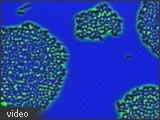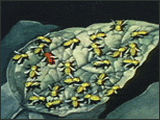

|
|
|
|||||||
|
|
||||||||
|
Why Does Evolution Matter Now? Evolution and Antibiotic and Pesticide Resistance When people go to the doctor's office, they expect to be cured. They don't like to be told, "Go home, drink lots of fluids and rest, and you will get better." They want a more proactive approach. Often, doctors prescribe antibiotics just to make their patients happy, even if the antibiotics cannot treat the illness at hand. As a result, antibiotics become more prevalent, the microbes they attack are more likely to develop resistance, and over time the antibiotics become ineffective. Learn about why some diseases have become antibiotic-resistant and how you can help address the problem.
2. Answer the following questions about the video segment:
3. If you have time, you may want to view the animated video The chemical arsenal we have developed in an attempt to rid our homes of rodents and our crops of insects is losing its power. We have simply caused pest populations to evolve, unintentionally applying artificial selection in the form of pesticides. Individuals with a higher tolerance for our poisons survive and breed, and soon resistant individuals out number the ones we can control. You and your research partner are responsible to complete a specific task. After you have gathered the necessary information, you will teach your partner what you have discovered.1. Click the links and answer the following questions.
|
||||||||||||||||||||||||||||||||||||||||||
|
Part C: Spreading the Word | |
|
1. |
Your teacher may divide the class into small groups. You and your teammates will work together as health professionals and researchers. (If you are at home, you can do this activity alone.) |
|
2. |
Your team has been hired to develop a public relations campaign to help inform the general public about the threat of antibiotic resistance. You will gather information and produce an educational piece (pamphlet, or brochure) to inform the general population. |
3. You will use the following websites to conduct your research:
http://whyfiles.org/038badbugs/
http://archives.cnn.com/2000/HEALTH/06/12/antibiotic.resistance/index.html
http://www.pbs.org/wgbh/evolution/library/10/4/l_104_03.html
|
An explanation of antibiotic resistance; An explanation of how natural selection influences the effectiveness of antibiotics and the virulence of infectious agents; Information about how national and international agencies combat antibiotic resistance; and Tips for how the public can help combat increased antibiotic resistance. | |||||||||||||||
5. Produce pamphlet, brochure or informational poster after your team's outline has been approved by your teacher.
| Site Map |


